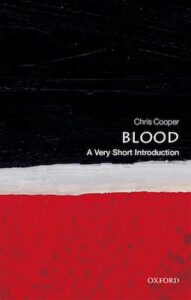As I lay on the dark blue lounge chair at the Portland Red Cross, quietly contemplating my blood flowing through the 16-gauge needle inserted into my median cubital vein, through the tube taped to my forearm, and down into the bag suspended just beside the chair, like any good naturalist I began to wonder just what it was about this dark red fluid that made it so special. After all, we all have it continually coursing through us from before our first and until our last drawn breath. Without it, we die; and should something unusual happen to it while we still live, the consequences to us can bring that last breath sooner than we might expect or prefer.
Serendipitously, it was later that very same week in which I learned of the forthcoming publication of Christopher Cooper’s Blood, A Very Short Introduction from Oxford University Press. Long an enthusiastic reader of the “VSI” series – in my opinion the best “pocket books” presently in print – I was particularly pleased to see that they had selected it as a subject. For since receiving the diagnosis of haemochromatosis that now requires me to have a pint drawn each week in pursuit of bringing my serum ferritin level down to a normal level and then keeping it there, I have become both keenly aware of, as well as curious about, blood in general, and my own in particular.
For as ubiquitous as blood is to every person reading this, as well as – with varying levels of difference in cellular and other structures, of course – with all members of the Phylum Chordata, most of us give this essential bodily fluid precious little thought; unless, like me, we discover something to be out of the ordinary with it. Yet as Cooper explains in one of the fascinating historically-focused passages of Blood, something being “out of the ordinary” with a person’s blood can have world-changing effects.
Had Queen Victoria’s grand-daughter Alix, for example, accepted the marriage proposal of her first cousin Albert (the eldest son of the future King Edward VII), the haemophilia that had sporadically afflicted the royal families of Europe for generations would have been all but permanently re-established in the British royal family. As Cooper very clearly explains, due to the X-chromosomal transmission of the disease, women can carry – as Alix and at least one of her sisters did – and transmit it, but, excluding rare exceptions, only men develop it. Of course, things took a rather different course entirely when she refused her first suitor and married Nicholas II of Russia. She thus became the Tsarina Alexandra and as a result unintentionally brought her own particular bloodline to an end.
Blood is over-flowing with such fascinating historical observations, as well as with an equally generous amount of practical information that everyone possessing blood should know. What distinguishes one blood type from another, for example, and what does the “negative” versus “positive” mean? What is blood pressure and why does it matter that we know what ours is? How is it that blood can be donated, stored, and transfused into another person – and what are the limitations of these activities?
And of course, as with most all volumes in the Very Short Introductions series, more complex information on the subject is also included for those who desire to dive deeper into the subject. For some, these bio-chemical, history of medicine, and other more, shall we say, high context, sections might be a bit further out into the deep end of the proverbial pool than they are comfortable swimming; however thanks to the subdivided organization of each chapter, it is not essential if everything in them is fully understood by all readers. In fact, for those not wishing to go too much farther out than where their feet can still touch bottom, they can simply be skimmed without any noticeable loss of comprehension when the next chapter is begun. (Of course, I always encourage readers to struggle through material they don’t fully comprehend with the idea that more is usually understood and retained than might at first be expected.)
Sharing one of the best qualities, to which I have already alluded, of all the volumes in the VSI series, Blood is the perfect size book to tuck into a jacket pocket – my trusty old tweed is never without one – for ready access whenever a well-deserved tea break may occur, when a queue is too long simply to stare off into space, or – naturally – when a nice bit of edifying reading is desired (and they are the ideal antidote for the modern disease of twiddling with mobile telephones to fill any available otherwise unoccupied period of time).
So fill your pocket with Blood and set out into the world, confident in the belief that the time spent reading it will enrich your knowledge and leave you flush with understanding of this fascinating and extraordinary substance we all share.
 Title: Blood: A Very Short Introduction
Title: Blood: A Very Short Introduction
Author: Christopher Cooper (Twitter: @profchriscooper)
Publisher: Oxford University Press
Series: Very Short Introductions
Format: Paperback
Pages: 144 pp.
ISBN: 9780199581450
Published: October 2016
In accordance with Federal Trade Commission 16 CFR Part 255, it is disclosed that the copy of the book read in order to produce this review was provided gratis to the reviewer by the publisher.
